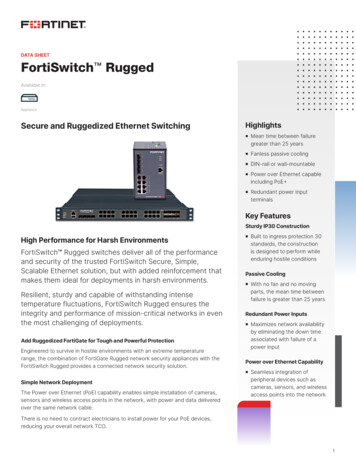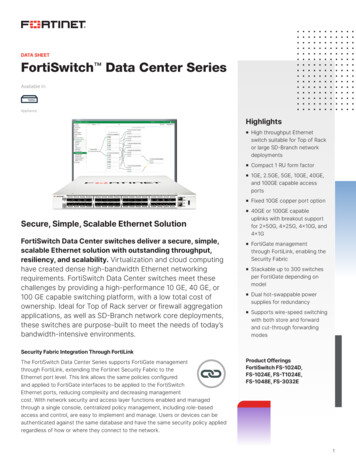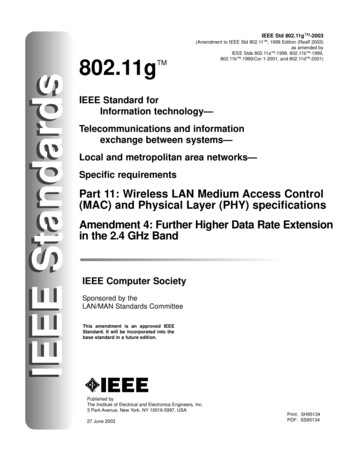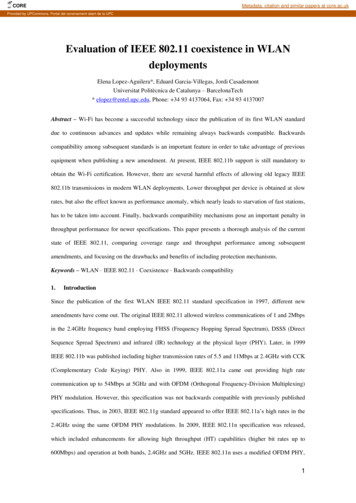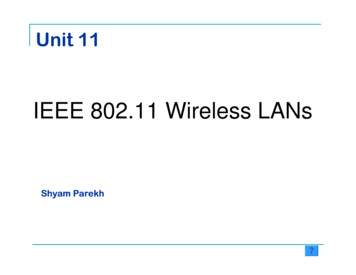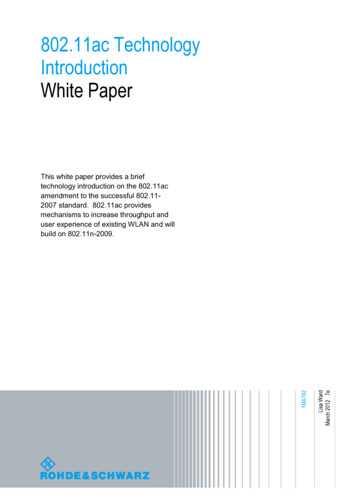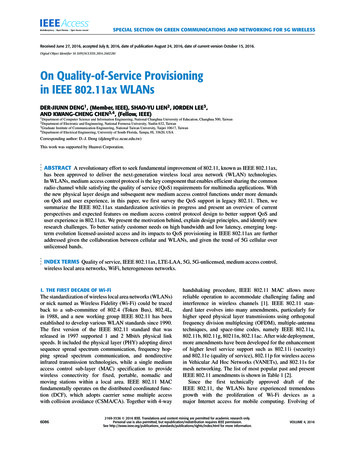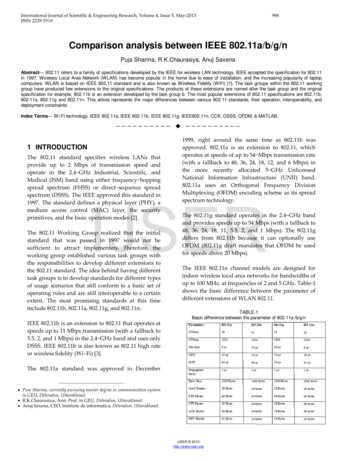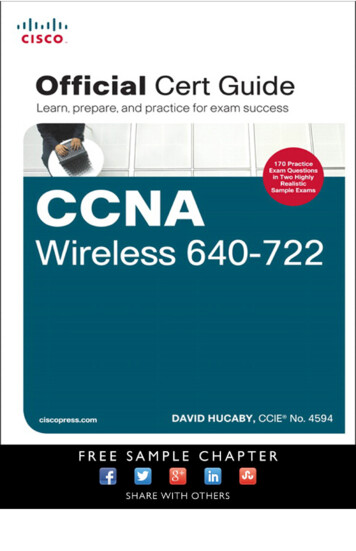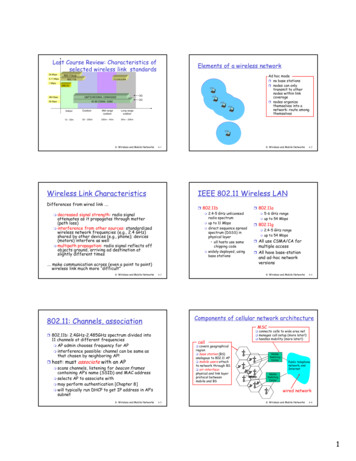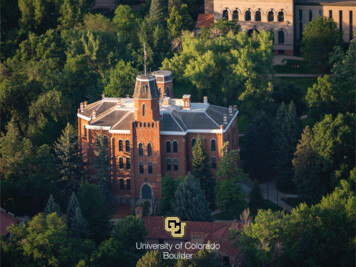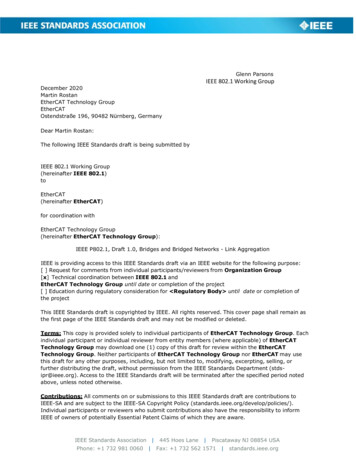
Transcription
Glenn ParsonsDecember 2020Martin RostanEtherCAT Technology GroupEtherCATOstendstraße 196, 90482 Nürnberg, GermanyIEEE 802.1 Working GroupDear Martin Rostan:The following IEEE Standards draft is being submitted byIEEE 802.1 Working Group(hereinafter IEEE 802.1)toEtherCAT(hereinafter EtherCAT)for coordination withEtherCAT Technology Group(hereinafter EtherCAT Technology Group):IEEE P802.1, Draft 1.0, Bridges and Bridged Networks - Link AggregationIEEE is providing access to this IEEE Standards draft via an IEEE website for the following purpose:[ ] Request for comments from individual participants/reviewers from Organization Group[x] Technical coordination between IEEE 802.1 andEtherCAT Technology Group until date or completion of the project[ ] Education during regulatory consideration for Regulatory Body until date or completion ofthe projectThis IEEE Standards draft is copyrighted by IEEE. All rights reserved. This cover page shall remain asthe first page of the IEEE Standards draft and may not be modified or deleted.Terms: This copy is provided solely to individual participants of EtherCAT Technology Group. Eachindividual participant or individual reviewer from entity members (where applicable) of EtherCATTechnology Group may download one (1) copy of this draft for review within the EtherCATTechnology Group. Neither participants of EtherCAT Technology Group nor EtherCAT may usethis draft for any other purposes, including, but not limited to, modifying, excerpting, selling, orfurther distributing the draft, without permission from the IEEE Standards Department (stdsipr@ieee.org). Access to the IEEE Standards draft will be terminated after the specified period notedabove, unless noted otherwise.Contributions: All comments on or submissions to this IEEE Standards draft are contributions toIEEE-SA and are subject to the IEEE-SA Copyright Policy (standards.ieee.org/develop/policies/).Individual participants or reviewers who submit contributions also have the responsibility to informIEEE of owners of potentially Essential Patent Claims of which they are aware.IEEE Standards Association Phone: 1 732 981 0060 445 Hoes Lane Piscataway NJ 08854 USAFax: 1 732 562 1571 standards.ieee.org
EEE P802.1AX-Rev/D1.0December 5, 2018IEEE P802.1AX-Rev/D1.0Draft Standard for Local and Metropolitan Area Networks—Bridges and Bridged Networks— LinkAggregationSponsorLAN/MAN Standards Committee of the IEEE Computer SocietyPrepared by the Time Sensitive Networking Task Group of IEEE 802.1Abstract: Link Aggregation allows parallel point-to-point links to be used as if they were a singlelink, and also supports the use of multiple links as a resilient load sharing interconnect betweenmultiple nodes in two separately administered networks. This standard defines a MAC independentLink Aggregation capability, and general information relevant to specific to MAC types.Keywords: Aggregated Link, Aggregator, Link Aggregation, Link Aggregation Group, local areanetwork, management, interconnect, Network-Network Interface, NNI, Distributed ResilientNetwork Interconnect, DRNI.DRAFT STATUS:Working Group ballot draft.Copyright 2018 by the Institute of Electrical and Electronics Engineers, Inc.Three Park AvenueNew York, New York 10016-5997, USAAll rights reserved.This document is an unapproved draft of a proposed IEEE Standard. As such, this document is subject to change. USE ATYOUR OWN RISK! IEEE copyright statements SHALL NOT BE REMOVED from draft or approved IEEE standards, ormodified in any way. Because this is an unapproved draft, this document must not be utilized for any conformance/compliance purposes. Permission is hereby granted for officers from each IEEE Standards Working Group or Committee toreproduce the draft document developed by that Working Group for purposes of international standardization consideration.IEEE Standards Department must be informed of the submission for consideration prior to any reproduction for internationalstandardization consideration (stds.ipr@ieee.org). Prior to adoption of this document, in whole or in part, by anotherstandards development organization, permission must first be obtained from the IEEE Standards Department(stds.ipr@ieee.org). When requesting permission, IEEE Standards Department will require a copy of the standarddevelopment organization's document highlighting the use of IEEE content. Other entities seeking permission to reproducethis document, in whole or in part, must also obtain permission from the IEEE Standards Department.IEEE Standards Activities Department445 Hoes LanePiscataway, NJ 08854, USA
Bridges and Bridged Networks— Link 5051525354IEEE P802.1AX-Rev/D1.0December 5, 2018IEEE Standards documents are developed within the IEEE Societies and the Standards Coordinating Committees of theIEEE Standards Association (IEEE-SA) Standards Board. The IEEE develops its standards through a consensus development process, approved by the American National Standards Institute, which brings together volunteers representing variedviewpoints and interests to achieve the final product. Volunteers are not necessarily members of the Institute and serve without compensation. While the IEEE administers the process and establishes rules to promote fairness in the consensus development process, the IEEE does not independently evaluate, test, or verify the accuracy of any of the information containedin its standards.Use of an IEEE Standard is wholly voluntary. The IEEE disclaims liability for any personal injury, property or other damage, of any nature whatsoever, whether special, indirect, consequential, or compensatory, directly or indirectly resultingfrom the publication, use of, or reliance upon this, or any other IEEE Standard document.The IEEE does not warrant or represent the accuracy or content of the material contained herein, and expressly disclaimsany express or implied warranty, including any implied warranty of merchantability or fitness for a specific purpose, or thatthe use of the material contained herein is free from patent infringement. IEEE Standards documents are supplied “AS IS.”The existence of an IEEE Standard does not imply that there are no other ways to produce, test, measure, purchase, market,or provide other goods and services related to the scope of the IEEE Standard. Furthermore, the viewpoint expressed at thetime a standard is approved and issued is subject to change brought about through developments in the state of the art andcomments received from users of the standard. Every IEEE Standard is subjected to review at least every five years for revision or reaffirmation. When a document is more than five years old and has not been reaffirmed, it is reasonable to concludethat its contents, although still of some value, do not wholly reflect the present state of the art. Users are cautioned to checkto determine that they have the latest edition of any IEEE Standard.In publishing and making this document available, the IEEE is not suggesting or rendering professional or other servicesfor, or on behalf of, any person or entity. Nor is the IEEE undertaking to perform any duty owed by any other person orentity to another. Any person utilizing this, and any other IEEE Standards document, should rely upon the advice of a competent professional in determining the exercise of reasonable care in any given circumstances.Comments for revision of IEEE Standards are welcome from any interested party, regardless of membership affiliation withIEEE. Suggestions for changes in documents should be in the form of a proposed change of text, together with appropriatesupporting comments. Comments on standards and requests for interpretations should be addressed to:Secretary, IEEE-SA Standards Board445 Hoes LanePiscataway, NJ 08854-4141USANote: Attention is called to the possibility that implementation of this standard may require use of subject matter covered by patent rights. By publication of this standard no position is taken with respect to the existence orvalidity of any patent rights in connection therewith. The IEEE is not responsible for identifying Essential Patent Claims for which a license may be required, for conducting inquiries into the legal validity or scope of Patents Claims or determining whether any licensing terms or conditions provided in connection with submissionof a Letter of Assurance, if any, or in any licensing agreements are reasonable or non-discriminatory. Users ofthis standard are expressly advised that determination of the validity of any patent rights, and the risk ofinfringement of such rights, is entirely their own responsibility. Further information may be obtained from theIEEE Standards Association.Authorization to photocopy portions of any individual standard for internal or personal use is granted by the Institute ofElectrical and Electronics Engineers, Inc., provided that the appropriate fee is paid to Copyright Clearance Center. Toarrange for payment of licensing fee, please contact Copyright Clearance Center, Customer Service, 222 Rosewood Drive,Danvers, MA 01923 USA; (978) 750-8400. Permission to photocopy portions of any individual standard for educationalclassroom use can also be obtained through the Copyright Clearance Center.iiCopyright 2018 IEEE. All rights reserved.This is an unapproved IEEE Standards Draft, subject to change.
Bridges and Bridged Networks— Link 5051525354IEEE P802.1AX-Rev/D1.0December 5, 2018Introduction to IEEE P802.1AX-Rev/D1.0 (This introduction is not part of IEEE P802.1AX-Rev/D1.0, Draft Standard for Local and Metropolitan Area Networks—Bridges and Bridged Networks— Link Aggregation.)Link Aggregation allows one or more links to be aggregated together to form a Link Aggregation Group(LAG), such that the Link Aggregation Client can treat the LAG as if it were a single link. Link Aggregationwas originally published as IEEE Std 802.3ad-2000 and subsequently incorporated into the IEEE Std 802.3,2000 Edition. In 2008 Link Aggregation was removed from IEEE Std 802.3 and published as IEEE Std802.1AX-2008. These standards specified the aggregation of full-duplex, point-to-point, links using IEEEStd 802.3 media of the same speed.An amendment, IEEE Std 802.1AXbk-2012, specified changes to the addressing used by the link aggregation control and marker protocols to allow a LAG to span Two-Port Media Access Control Relays and tospan Provider Bridged Networks and Provider Backbone Bridge Networks.A revision, IEEE Std 802.1AX-2014, extended Link Aggregation in three areas. First, it explicitly allowedthe aggregation of point-to-point links of any speed using any physical media or logical connection capableof supporting the Internal Sublayer Service specified in IEEE Std 802.1AC. Second, it specified Conversation-Sensitive Collection and Distribution (CSCD) that provides a mechanism to identify the distributionalgorithm in use to map data frames to individual links in the LAG, and to convey that information to theLink Aggregation Partner via Link Aggregation Control Protocol Data Units (LACPDUs) containing version 2 TLVs. Third, it specified Distributed Resilient Network Interconnect (DRNI) that allows a LAG toterminate at two or three cooperating Systems such that the LAG provides resiliency to System level failuresas well as link level failures. A corrigendum, IEEE Std 802.1AX-2014/Cor 1-2017, provided technical andeditorial corrections to CSCD.This revision, IEEE P802.1AX-Rev/D1.0, makes significant refinements and simplifications to the Link AggregationControl Protocol (LACP) as well as to CSCD and DRNI. In LACP, the Periodic state machine and Transmit Statemachine are combined to a single machine, and the Mux machine is optimized to reduce the likelihood of excessiveLACPDU transmissions. CSCD is refined to eliminate the TLVs that led to LACPDUs greater than 128 bytes in length.DRNI is significantly revised and simplified to support a LAG terminating at just two (not three) cooperating Systems.Every effort has been made to maintain interoperability, without prior configuration, with LACP implementations conforming to IEEE Std 802.3ad-2000, IEEE Std 802.1AX-2008, or IEEE Std 802.1AX-2014, andwith CSCD implementations conforming to IEEE Std 802.1AX-2014. The changes to DRNI, and in particular the Distributed Relay Control Protocol (DRCP), are such that an implementation conforming to this standard will not interoperate with a DRCP implementation conforming to IEEE Std 802.1AX-2014. The DRCPversion number in this standard has been changed to version 2, and care has been taken that a DRCP implementation conformant to IEEE Std 802.1AX-2014 will discard version 2 DRCPDUs as invalid, and thatimplementations of this standard will discard version 1 DRCPDUs. Editor’s Note: Standard boilerplate material goes here, such as patent policy etc. This standard contains state-of-the-art material. The area covered by this standard is undergoing evolution.Revisions are anticipated within the next few years to clarify existing material, to correct possible errors, andto incorporate new related material. Information on the current revision state of this and other IEEE 802standards may be obtained fromSecretary, IEEE-SA Standards Board445 Hoes LanePiscataway, NJ 08854-4141USACopyright 2018 IEEE. All rights reserved.This is an unapproved IEEE Standards Draft, subject to change.iii
Bridges and Bridged Networks— Link 5051525354IEEE P802.1AX-Rev/D1.0December 5, 2018ParticipantsAt the time this standard was submitted to the IEEE-SA for approval, the IEEE P802.1 Working Group hadthe following membership:Glenn Parsons, ChairJohn Messenger, Vice ChairJanos Farkas, Chair, Time-Sensitive Networking Task GroupStephen Haddock, Jessy Rouyer, Co-editors TBA The following members of the balloting committee voted on this standard. Balloters may have voted forapproval, disapproval, or abstention. TBA When the IEEE-SA Standards Board approved this standard on TBA , it had the followingmembership: TBA , Chair TBA , Vice Chair TBA , Secretary TBA Copyright 2018 IEEE. All rights reserved.This is an unapproved IEEE Standards Draft, subject to change.iv
Bridges and Bridged Networks— Link 5051525354IEEE P802.1AX-Rev/D1.0December 5, 2018Editors’ Foreword Throughout this document, all notes such as this one, presented between angle braces, are temporarynotes inserted by the Editors for a variety of purposes. Certain text is also highlighted to attract the attentionof reviewers. These notes and highlights, the temporary Annex Z (if present) containing some discussion ofissues, the Editors’ Foreword and Introduction to the current draft, and the preceding cover pages, will beremoved prior to Sponsor Ballot and publication and are not part of the normative text. The records ofparticipants in the development of the standard will be added at an appropriate time. Comments and participation in 802.1 standards developmentComments on this draft are encouraged. NOTE: All issues related to IEEE standards presentation style,formatting, spelling, etc. are routinely handled between the 802.1 Editor and the IEEE Staff Editors prior topublication, after balloting and the process of achieving agreement on the technical content of the standard iscomplete. Readers are urged to devote their valuable time and energy only to comments that materiallyaffect either the technical content of the document or the clarity of that technical content. Comments shouldnot simply state what is wrong, but also what might be done to fix the problem.Full participation in the development of this draft requires attendance at IEEE 802 meetings. Information on802.1 activities, working papers, and email distribution lists etc. can be found on the 802.1 Website:http://ieee802.org/1/Use of the email distribution list is not presently restricted to 802.1 members, and the working group has apolicy of considering ballot comments from all who are interested and willing to contribute to thedevelopment of the draft. Individuals not attending meetings have helped to identify sources ofmisunderstanding and ambiguity in past projects. The email lists exist primarily to allow the members of theworking group to develop standards, and are not a general forum. All contributors to the work of 802.1should familiarize themselves with the IEEE patent policy and anyone using the email distribution will beassumed to have done so. Information can be found athttp://standards.ieee.org/db/patents/Comments on this document may be sent to the 802.1 email exploder, to the Editor, or to the Chairs of the802.1 Working Group and Time Sensitive Networking Task Group.Stephen HaddockCo-Editor, P802.1AX-REV-2Email: shaddock@stanfordalumni.orgJessy RouyerCo-Editor P802.1AX-REV-2Email: jessy.rouyer@nokia.comJános FarkasGlenn ParsonsChair, 802.1 Working GroupEmail: glenn.parsons@ericsson.comChair, 802.1 TSN Task GroupEmail: janos.farkas@ericsson.comNOTE: Comments whose distribution is restricted in any way cannot be considered, and may not beacknowledged.All participants in IEEE standards development have responsibilities under the IEEE patent policy andshould familiarize themselves with that policy, erials.htmlCopyright 2018 IEEE. All rights reserved.This is an unapproved IEEE Standards Draft, subject to change.v
Bridges and Bridged Networks— Link 5051525354IEEE P802.1AX-Rev/D1.0December 5, 2018Project Authorization Request (PAR) and Criteria for StandardsDevelopment (CSD)The text of the PAR that was submitted for this project can be found le/P802.1AX.pdf?t 89522200003Note that there are no CSD for this maintenance PAR.As part of our IEEE 802 process, the text of the PAR and CSD should be reviewed on a regular basis in orderto ensure their continued validity. A vote of “Approve” on this draft is assumed also to be an affirmation bythe balloter that the text of the PAR and CSD are still valid. Editor’sIntroduction to draft 1.0:Draft for Working Group ballot. The change bars in this draft are with respect to draft 0.4. The following isan summary of the major changes:1)2)3)4)Resolution of comments from the third Task Force ballot (see ts/d0/802-1AX-Rev-d0-4-dis-v01.pdf).Updated MIB in Annex D to match Clause 7 managed objects.Updated PICS in Annex A.Added CSCD overview diagram based on ev-seaman-cscd-in-a-nutsell-0518-v01.pdf. Editor’sIntroduction to draft 0.4:Draft for the third Task Force ballot. This is a “clean” document without change bars or insert/strikeout text.The following is an summary of the major changes:1)2)3)4)5)Resolution of comments from the second Task Force ballot (see ts/d0/802-1AX-Rev-d0-3-dis-v01.pdf).Significant changes to the definitions in Clause 3, based on ant re-write of the subclauses introducing Conversation-sensitive Collection andDistribution (6.6), based on t changes to Distributed Resilient Network Interface (DRNI, Clause 9):a), Change from the “DR-component” model to the “DR-sublayer” model of the DistributedRelay.b)Terminology changes eliminating the term “Portal”.c)Re-write of the introductory subclauses, based on rev-seaman-dnri-suggestions-0718-v01.pdf.Update to Clause 7 managed objects, including deprecating many many managed objectsintroduced IEEE Std 802.1AX-2014, and the addition of numerous new objects.Note that Annex A (PICS) and Annex D (MIB) have not been updated to be consistent with the changes inthe other Clauses. It is recommended that reviewers not spend time reviewing or commenting on theseClauses. Comments on the material in Clause 9 in particular are requested. Copyright 2018 IEEE. All rights reserved.This is an unapproved IEEE Standards Draft, subject to change.vi
Bridges and Bridged Networks— Link 5051525354 Editor’sIEEE P802.1AX-Rev/D1.0December 5, 2018Introduction to draft 0.3:Draft for the second Task Force ballot. Change bars and insert/strikeout text in Clauses 5 and 6 is relative todraft 0.1 (which was the draft for the first Task Force ballot). Changes in Clauses 8 and 9 are so substantivethat insert/strikeout text is not shown, and all text should be reviewed as new material. The following is ansummary of the major changes:1)2)3)Resolution of comments from the first Task Force ballot (see ts/d0/802-1AX-Rev-d0-1-dis-v01.pdf).Modification of LACP state machines, including updates to the Receive and Mux machines,combining the Periodic and Transmit machines, and eliminating the Churn machines, per seaman-lacp-suggestions-0118-02.pdf.Major overhaul of Clause 8 and 9 as discussed during the last several meetings (andsummarized in the Editor’s reports). In particular the November 2017 decision to limit thenumber of Portal Systems in a Portal to two.Note that Clause 7 (management), Annex A (PICS), and Annex D (MIB) have not been updated to beconsistent with the changes in the other Clauses. It is recommended that reviewers not spend time reviewingor commenting on these Clauses. Comments on the material in Clause 9 in particular are requested. Editor’sIntroduction to draft 0.1:Draft for the first Task Force ballot. Change bars and insert/strikeout text is relative to draft 0.0 which was amerge of 802.1AX-2014 and 802.1AX-2014-Cor1-2017. The bulk of the changes are in Clause 6. Otherclauses, in particular Clause 9, have very few modifications as of yet. While comments on any part of thedocument are always welcome, readers are encouraged to focus their review on the modifications in Clause6. The following is an overview of these changes.At the September 2016 interim meeting in York it was agreed that the Conversation-Sensitive LACP statemachines that are essentially modifications of existing LACP state machines should be integrated with theexisting state machines. This draft leaves the variable and function definitions that are specific toConversation-Sensitive LACP, and only necessary when Conversation-Sensitive Collection and Distributionis supported, in clause 6.6, but the invocation of these functions is merged into the existing LACP statemachines. Specifically:d)a)b)c)The Conversation-Sensitive Collection state machine is removed from 6.6, and replaced withmodifications to that Aggregator Parser state machine (6.2.7) to specify operation withConversation-sensitive Collection. An Aggregator Multiplexer state machine is added to specifyoperation with Conversation-sensitive Distribution.The Verification state machine is removed from 6.6, and the functionality merged into therecordDefault and recordPDU functions of the Receive state machine (6.4.11).The Receive Long LACPDU state machine is removed from 6.6, and the functionality merged intothe recordPDU function of the Receive state machine (6.4.11).The Update Mask state machine is modified to be a per-Aggregator machine, to correct operationwhen one or more Aggregation Ports attached to the Aggregator are defaulted, and to incorporateeffects of management changes to Conversation-sensitive Distribution and Collection administrativevariables.In keeping with the discussions at the January 2017 interim meeting in Atlanta, the following changes weremade:Copyright 2018 IEEE. All rights reserved.This is an unapproved IEEE Standards Draft, subject to change.vii
IEEE P802.1AX-Rev/D1.0December 5, 354d)e)LOCAL AND METROPOLITAN AREA NETWORKSIncorporated suggestions from ax-rev-seaman-wait-to-restore-0117-v01.pdf, most significantlyreplacing the existing Mux state machines (6.4.13) with the state machine proposed in Figure 4.Aligning the draft with 802.1AC by making the correlation between 802.1AX variables and ISSstatus parameters more explicit. This includes changing the port enabled variable toPort Operational, replacing the Transmit State and Receive State variables withAggregator Operational, adding an Aggregator Enabled variable and specifying its behavior in theSelection Logic, and adding cross-references between these variables and the existingaAggAdminState and aAggOperState managed objects.Additionally:f)g)Clarified the distinction between Aggregator and Aggregation Port identifiers that are ifIndex valuesused by management, and the Port Number and Port Identifier used by LACP and conveyed inLACPDUs.Added informative text on the configuration and operation of Conversation-sensitive Distributionand Collection (6.6.1, 6.6.3, 6.6.3). Editor’sIntroduction to draft 0.0:This draft is a merge of 802.1AX-2014 and 802.1AX-2014-Cor1-2017. viiiCopyright 2018 IEEE. All rights reserved.This is an unapproved IEEE Standards Draft, subject to change.
Bridges and Bridged Networks— Link 5051525354IEEE P802.1AX-Rev/D1.0December 5, 2018Contents1.Overview. 11.11.21.3Scope. 1Purpose. 1State diagram conventions . 22.Normative references . 33.Definitions . 44.Acronyms and abbreviations . 75.Conformance. 85.15.25.35.46.Requirements terminology. 8Protocol Implementation Conformance Statement. 8Link Aggregation requirements . 85.3.1Link Aggregation options . 8Distributed Resilient Network Interconnect requirements . 95.4.1Distribution Resilient Network Interconnect options . 9Link Aggregation . 126.16.26.3Overview. 126.1.1Goals and objectives . 126.1.2Positioning of Link Aggregation within the IEEE 802 architecture. 136.1.3Protocol Parser/Multiplexer . 146.1.3.1 Protocol Parser state diagram . 15Link Aggregation operation. 166.2.1Principles of Link Aggregation. 176.2.2Service interfaces . 186.2.3Frame Collector . 186.2.3.1 Frame Collector state diagram . 196.2.4Frame Distributor. 206.2.4.1 Frame Distributor state diagram . 216.2.5Marker Generator/Receiver (optional). 216.2.6Marker Responder. 226.2.7Aggregator Parser/Multiplexer . 226.2.7.1 Aggregator Parser/Multiplexer state diagrams .
December 2020 Martin Rostan EtherCAT Technology Group EtherCAT Ostendstraße 196, 90482 Nürnberg, Germany Dear Martin Rostan:

